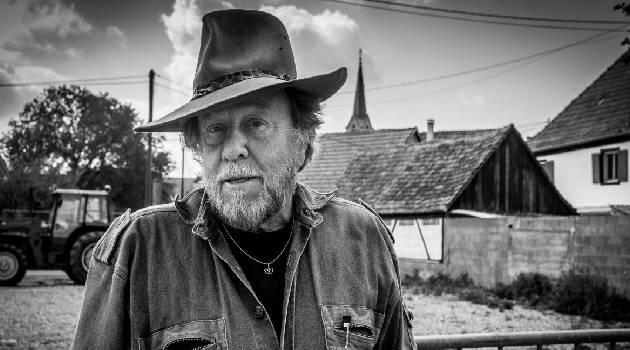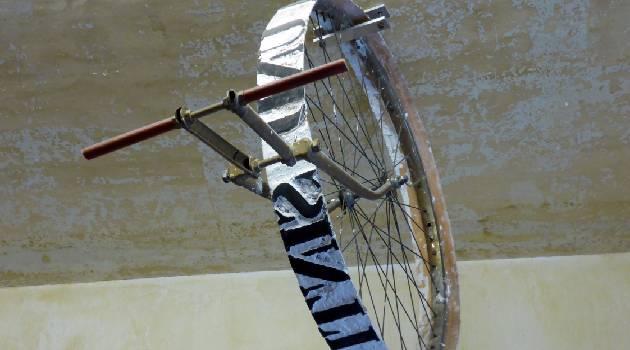Gunter Demnig marked the Nazi deportation route of thousands of Roma and Sinti from Cologne, Germany, then invented the Stolpersteine

The Stolpersteine, which in the Czech language are being called the Stones of the Disappeared (Kameny zmizelých), is a project created by the German artist Gunter Demnig. During the 30 years of its existence almost 90 000 stones have been installed in 26 countries, the biggest decentralized memorial in the world dedicated to the victims of Nazism.
Since 2008 it has been possible to see the Stones of the Disappeared in the streets of towns across the Czech Republic. The 10x10cm brass plates are affixed to the tops of cobblestones and inlaid into the sidewalks in front of the last known residences of the victims of the Nazi regime in order to preserve the memory of the people who were murdered or persecuted by the Nazis between 1933 and 1945.
Stolperstein literally means “stumbling block”. Katja Demnig, Gunter’s wife and close collaborator, explains the origin of the name to Romano voďi magazine: “Gunter is frequently asked that question. He no longer exactly recalls how it occurred to him. He sincerely believed he was giving a name to a one-off artistic happening, nobody anticipated what a voluminous art project this would grow into. He liked the ambiguity of the name, he wanted to get people to stop in their tracks, to interrupt the flow of their everyday thinking.”
Returning stories to the streets
The beginning of this art project extends back to the 50th anniversary of the deportation of thousands of Romani and Sinti people from Cologne to the Nazi concentration camps. On 6 May 1990, Demnig used a custom-built wheel that, when dipped in paint and rolled along the street, left the message EINE SPUR DURCHS VERGESSEN (A TRAIL THROUGH OBLIVION) to indicate the entire route along which these people had been deported.

For the Nazis, the Cologne deportation was a dress rehearsal for the subsequent deportation of the Jews. The city of Cologne subsequently had several sections of that route permanently inscribed with those words to commemorate the deportation.
“When Gunter was mounting the brass letters of the inscription, an older woman reached out to him. She praised the project, but she also expressed doubts as to whether any ‘Gypsies’ had actually been living in her neighborhood back then,” Katya Demnig says.
“Ever since, Gunter has been thinking about how to return the memory of specific people and their stories that have already been lost to our cities and streets,” his wife says. The first prototype of such a cobblestone capped by a brass plate was installed by Demnig into the pavement in front of Cologne’s historical City Hall on 16 December 1992 to commemorate the 50th anniversary of the decree issued by Heinrich Himmler ordering the deportation of the Roma and Sinti to Auschwitz.
The first lines of the decree are engraved into the stones and the remaining text is then hidden in the cavity into which the cobblestones are set. During the following years, Demnig created the concept of cobblestones dedicated to specific individuals.
The artist was inspired by the words of the Talmud: “The person is not forgotten until their name is forgotten.” The first 230 such stones were presented in 1994 as a theoretical concept at an exhibition in the Antoniterkirche in Cologne.
A local parson then asked Demnig to install several of the stones as a symbolic gesture. On 4 January 1995 the first Stolpersteine were laid commemorating specific victims of Nazism, without seeking administrative permission.
Ms Demnig explained why cobblestones were chosen: “Originally Gunter considered memorial plaques on the exterior walls of buildings, but after consultations he abandoned that idea because to get permission to install plaques from each owner of each property would have taken too long and frequently would not have succeeded. Several of the buildings are no longer standing. When installing cobblestones in the sidewalk one ‘just’ needs municipal permission. The stones are visible, but they do not disrupt the character of the location.”
Gunter Demnig welcomed another aspect of installing the plates into the ground, and that is that people must bow their heads to read them, thereby bowing their heads to the memory of the victim. To this day the artist installs most of the stones himself.
“That is a component of the idea of the entire Stolpersteine project. He wants to be at the location to guarantee the dignified installation of the stone, to interact with those present, and to pay attention to and commemorate the specific person to whom the Stolperstein is dedicated,” his wife said.
“This entire process is meant to be a contrast to the mass murder that was perpetrated by the Nazis, during which individual people were of no consequence,” explains Ms Demnig as to why the couple are not taking a mass-production approach to the annual, constant growth of interest in more such stones being installed and the pressure to do so. The care dedicated to each of the stones means there is a limited capacity as to how many it is possible to install every year all over Europe.
The entire process of applying for permission, documenting the people to be commemorated, and the handicraft production of the stone by a sculptor means it takes more than a year before the stone is inlaid into a sidewalk. Agreements are currently underway for the laying of such stones as far out as October 2022.
Demnig patented the Stolpersteine in 2003 and since 2015 has been producing and installing them under the rubric of the Gunter Demnig Trail Foundation (Stiftung – Spuren – Gunter Demnig). It is also possible to see hundreds of imitations of the Stolpersteine all over Europe that are called Gedenksteine – Memorial Stones.
Memories being trampled
The project has not received a positive response from everybody. Several municipalities have refused permission to install the stones, most frequently by arguing that they are concerned the memorials could be vandalized.
Some condition the granting of permission on whether the local Jewish community agrees. Some families have rejected the installation of Stolpersteine for their loved ones because it seems undignified to them to have the names installed in the sidewalk beneath people’s feet.
The most vocal opponent of the art project is Charlotte Knobloch, president of the Jewish Community of Munich, who achieved a ban on installing the Stolpersteine into municipally-owned sidewalks there. Even so there are hundreds throughout the city located on private land, and initiatives based on supporting the Stolpersteine in the streets of Munich have been holding debates over the years about the appropriate forms of commemorating the victims of Nazism in public spaces reverentially.
Gunter Demnig recalled for Romano voďi magazine what the reaction was like to the project from the relatives of Romani and Sinti victims and admitted that in their case the laying of the stones was also more complicated: “I recall how one older Sinti woman was concerned that women would be walking over the stones. Given the perception of women as impure, that would have been a desecration. Her opinion did not predominate, though. Young people were, on the contrary, quite self-aware in that respect – ‘Naturally we want to restore the names of our loved ones!’ However, despite that it was a difficult process. The Central Council of German Sinti and Roma, for example, had similar concerns as Charlotte Knobloch in Munich: These people are being trampled on just like the Nazis trampled on them. The Nazis weren’t satisfied with mere trampling, though – theirs was a murderous program. In the interim that mood has been overcome and many families want Stolpersteine installed.”
The Stolpersteine in the Czech Republic
The installation of the first stones into the pavements of Prague was initiated in the Czech Republic by the Czech Union of Jewish Youth in the autumn of 2008, and in 2018 the project was revived after two years of inactivity by the chair of the Jewish Community in Prague, František Bányai, through the Public Benefit Association Supporting Persons Affected by the Holocaust. Currently there are 500 “Stones of the Disappeared” in Prague and hundreds more have been installed all over the Czech Republic.
The country’s first Stolpersteine for Romani victims were laid on 30 September 2017 in Brno’s Černovičký neighborhood and commemorate the married couple of Amálie Danielová and Jan Daniel, who were abducted with most of their friends and relatives from that colony and sent to the Auschwitz II-Birkenau Concentration Camp in the transport of 7 March 1943, where they lost their lives soon after arriving. In addition to many initiatives advocating the installation of new stones, projects to care for the existing ones are also being born.
The Lauder School in Prague has initiated a program of adopting stones where pupils are able to take charge of selected Stolpersteine and regularly clean them so the inscriptions remain legible. Trevor Sage, a British man, is already well-known in Prague for having moved here as a pensioner and having become so inspired by the brass-plated cobblestones that he regularly cleans them and also documents their existence.
Vandalism
One of the ideas behind the birth of the Stolpersteine was also making them accessible to the public so memory can be honored without having to pay attention to a memorial’s opening hours or paying an entrance fee. Accessibility, however, has a flip side that turns up when the stones are damaged or stolen.
The first Stolperstein laid in front of the Cologne City Hall was even stolen in 2010. In cases of vandalism, it has been demonstrated that such damage can have unintended outcomes.
For example, last year’s spray-painting of the Stolperstein for the Romani boxer Johann “Rukeli” Trollmann, Germany’s middleweight champion of 1933, caused an uproar. Several days before the celebrations of the 75th anniversary of the end of WWII, somebody spray-painted the runes of the SS over the stone with Trollmann’s name in Hamburg’s St. Pauli quarter.
Representatives of the Central Council of German Sinti and Roma condemned the deed and expressed public support for the Stolpersteine project, referencing the necessity of the commemorating of historical events as an opportunity to draw attention to the importance of human rights activities combating right-wing extremism.
First published in Romano voďi magazine.
